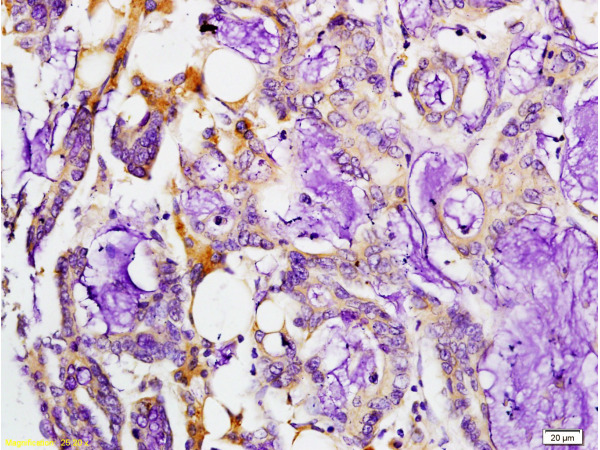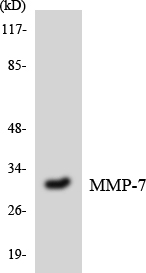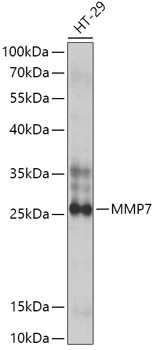MMP7 antibody [C2C3], C-term
GTX104658
ApplicationsWestern Blot, ELISA, ImmunoHistoChemistry, ImmunoHistoChemistry Paraffin
Product group Antibodies
TargetMMP7
Overview
- SupplierGeneTex
- Product NameMMP7 antibody [C2C3], C-term
- Delivery Days Customer9
- Application Supplier NoteWB: 1:500-1:3000. *Optimal dilutions/concentrations should be determined by the researcher.Not tested in other applications.
- ApplicationsWestern Blot, ELISA, ImmunoHistoChemistry, ImmunoHistoChemistry Paraffin
- CertificationResearch Use Only
- ClonalityPolyclonal
- Concentration0.45 mg/ml
- ConjugateUnconjugated
- Gene ID4316
- Target nameMMP7
- Target descriptionmatrix metallopeptidase 7
- Target synonymsMMP-7, MPSL1, PUMP-1, matrilysin, matrin, matrix metallopeptidase 7 (matrilysin, uterine), matrix metalloproteinase 7 (matrilysin, uterine), matrix metalloproteinase-7, pump-1 protease, uterine matrilysin, uterine metalloproteinase
- HostRabbit
- IsotypeIgG
- Protein IDP09237
- Protein NameMatrilysin
- Scientific DescriptionProteins of the matrix metalloproteinase (MMP) family are involved in the breakdown of extracellular matrix in normal physiological processes, such as embryonic development, reproduction, and tissue remodeling, as well as in disease processes, such as arthritis and metastasis. Most MMPs are secreted as inactive proproteins which are activated when cleaved by extracellular proteinases. The enzyme encoded by this gene degrades proteoglycans, fibronectin, elastin and casein and differs from most MMP family members in that it lacks a conserved C-terminal protein domain. The enzyme is involved in wound healing, and studies in mice suggest that it regulates the activity of defensins in intestinal mucosa. The gene is part of a cluster of MMP genes which localize to chromosome 11q22.3. [provided by RefSeq]
- Storage Instruction-20°C or -80°C,2°C to 8°C
- UNSPSC12352203
References
- Hsieh TY, Chang Y, Wang SJ. Piperine Provides Neuroprotection against Kainic Acid-Induced Neurotoxicity via Maintaining NGF Signalling Pathway. Molecules. 2022,27(9). doi: 10.3390/molecules27092638Read this paper
- Min S, Lee YK, Hong J, et al. MRPS31 loss is a key driver of mitochondrial deregulation and hepatocellular carcinoma aggressiveness. Cell Death Dis. 2021,12(11):1076. doi: 10.1038/s41419-021-04370-8Read this paper
- Miao J, Huang J, Luo C, et al. Klotho retards renal fibrosis through targeting mitochondrial dysfunction and cellular senescence in renal tubular cells. Physiol Rep. 2021,9(2):e14696. doi: 10.14814/phy2.14696Read this paper
- Zhou D, Fu H, Liu S, et al. Early activation of fibroblasts is required for kidney repair and regeneration after injury. FASEB J. 2019,33(11):12576-12587. doi: 10.1096/fj.201900651RRRead this paper
- Wang P, Gorter RP, de Jonge JC, et al. MMP7 cleaves remyelination-impairing fibronectin aggregates and its expression is reduced in chronic multiple sclerosis lesions. Glia. 2018,66(8):1625-1643. doi: 10.1002/glia.23328Read this paper
- Luo W, Liao M, Liao Y, et al. The role of kinesin KIF18A in the invasion and metastasis of hepatocellular carcinoma. World J Surg Oncol. 2018,16(1):36. doi: 10.1186/s12957-018-1342-5Read this paper
- Luo C, Zhou S, Zhou Z, et al. Wnt9a Promotes Renal Fibrosis by Accelerating Cellular Senescence in Tubular Epithelial Cells. J Am Soc Nephrol. 2018,29(4):1238-1256. doi: 10.1681/ASN.2017050574Read this paper
- Cai T, Sun D, Duan Y, et al. FHL2 promotes tubular epithelial-to-mesenchymal transition through modulating β-catenin signalling. J Cell Mol Med. 2018,22(3):1684-1695. doi: 10.1111/jcmm.13446Read this paper
- Pei YF, Yin XM, Liu XQ. TOP2A induces malignant character of pancreatic cancer through activating β-catenin signaling pathway. Biochim Biophys Acta Mol Basis Dis. 2018,1864(1):197-207. doi: 10.1016/j.bbadis.2017.10.019Read this paper
- Mo H, Wu Q, Miao J, et al. C-X-C Chemokine Receptor Type 4 Plays a Crucial Role in Mediating Oxidative Stress-Induced Podocyte Injury. Antioxid Redox Signal. 2017,27(6):345-362. doi: 10.1089/ars.2016.6758Read this paper








![IHC-P analysis of formalin fixed human placenta tissue using GTX52475 MMP7 antibody [4C21].](https://www.genetex.com/upload/website/prouct_img/normal/GTX52475/GTX52475_20191119_IHC-P_w_23060900_940.webp)